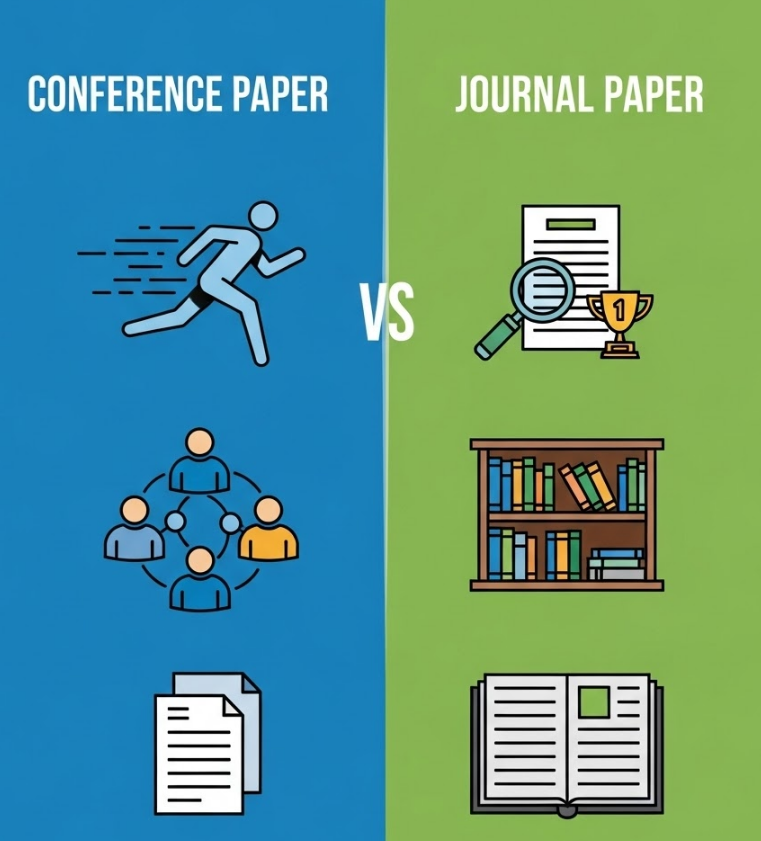

74 views||Release time: Oct 10, 2025
In academic publishing, the two primary venues for sharing your research are conferences and journals. Both are vital for career progression, but they serve different purposes and have distinct processes, levels of prestige, and impact. For many researchers, the term "SCI-indexed" adds another layer of complexity.
So, what is the difference between a conference paper and a journal paper? This guide breaks down the comparison to help you decide which path is right for your research.

First, let's clarify the term "SCI." The Science Citation Index (SCI) is a database created by the Institute for Scientific Information (ISI), which is now owned by Clarivate. Today, when academics refer to an "SCI paper," they are generally referring to a paper published in a journal that is indexed in the Web of Science (WoS) Core Collection, specifically the Science Citation Index Expanded (SCIE).
Primarily, Web of Science indexes journals.
However, it also has a Conference Proceedings Citation Index (CPCI). So, some high-quality conference papers can be indexed in the Web of Science, but they are tracked differently from journal articles.
With that in mind, let's compare the two types of publications.
Conference Paper: The primary goal is speed and dissemination. It's designed to present new, timely, and often preliminary findings to a specific community. It's a "snapshot" of your current research, perfect for getting early feedback from experts in your field during the conference event.
Journal Paper: The goal is to create a complete and permanent archival record. It presents a full, comprehensive, and well-developed study that has reached its final conclusions. It is intended to be the definitive, authoritative account of your research.
Conference Paper: The review process is generally faster and less exhaustive. Reviewers often have a tight deadline and are primarily focused on novelty, relevance to the conference, and correctness. The goal is to select a strong program of talks and posters. Revisions are typically minor.
Journal Paper: The review is far more rigorous, in-depth, and lengthy. It often involves multiple rounds of major revisions, where reviewers scrutinize every detail of the methodology, analysis, and conclusions. The process can take from six months to well over a year.
Conference Paper: Fast. The cycle from submission to presentation and publication in the proceedings is typically around 3-6 months.
Journal Paper: Slow. The cycle from submission to final publication can take 6 months to 2+ years.
This is the most nuanced difference and is highly dependent on your academic field.
In Most Fields (e.g., Life Sciences, Chemistry, Medicine, Social Sciences): Journal papers are the gold standard. A publication in a high-impact, SCI-indexed journal is considered far more prestigious and valuable for career advancement than a conference paper.
In Fast-Moving Fields (e.g., Computer Science, AI, Robotics, Engineering): Top-tier (flagship) conference papers are primary publications. In these fields, conferences are the main venues for disseminating cutting-edge research. A paper in a conference like NeurIPS, CVPR, or ICML is often considered more prestigious than a publication in many SCI journals.
| Feature | Conference Paper | Journal Paper |
| Primary Goal | Speed, Early Feedback, Networking | Archival Record, Prestige, Detail |
| Review Process | Faster, less rigorous | Slower, highly rigorous |
| Publication Speed | 3-6 months | 6-24+ months |
| Length & Detail | Shorter, concise (e.g., 6-10 pages) | Longer, comprehensive, in-depth |
| Prestige | Varies by field; very high in CS/Eng. | Generally very high across all fields |
| Indexing | Indexed in CPCI (WoS) or other DBs | Indexed in SCIE (WoS), the "gold standard" |
The two are not mutually exclusive. A common and highly effective strategy is to:
Present preliminary findings in a conference paper.
Use the feedback received at the conference to conduct further experiments and analysis.
Write a more detailed, comprehensive journal paper that extends the work, and submit it to an SCI-indexed journal.
Many conferences even partner with journals to invite the "best papers" for submission to a special issue, providing a direct pathway from conference to journal publication.
Conclusion: The choice between submitting to a conference or a journal depends on your field, the maturity of your research, and your primary goal. For rapid dissemination and feedback, conferences are ideal. For creating a permanent, high-prestige record of your completed work, journals are the ultimate destination.